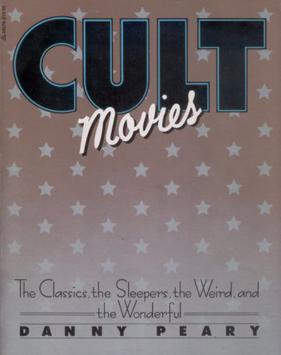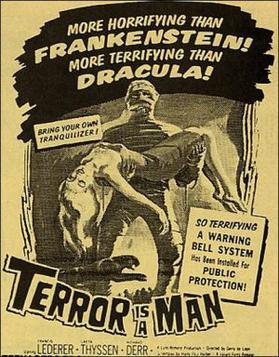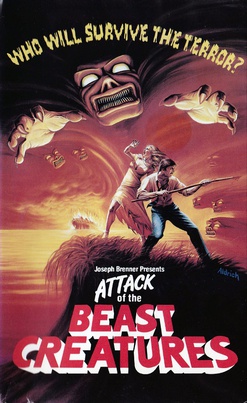
A fanzine is a non-professional and non-official publication produced by enthusiasts of a particular cultural phenomenon for the pleasure of others who share their interest. The term was coined in an October 1940 science fiction fanzine by Russ Chauvenet and first popularized within science fiction fandom, and from there the term was adopted by other communities.

Albert Victor Adamson Jr. was an American filmmaker and actor known as a prolific director of B-grade horror and exploitation films throughout the 1960s and 1970s.

Sidney Eddie Mosesian, known professionally as Sid Haig, was an American actor. He was known for his appearances in horror films, most notably his role as Captain Spaulding in the Rob Zombie films House of 1000 Corpses, The Devil's Rejects and 3 from Hell. Haig's Captain Spaulding, and Haig himself, have been called icons of horror cinema. Haig had a leading role on the television series Jason of Star Command as the villain Dragos. He appeared in many television programs, including The Untouchables, Batman, Gunsmoke, Mission: Impossible, Mary Hartman, Mary Hartman, Star Trek, Get Smart, The Rockford Files, Charlie's Angels, Fantasy Island, Buck Rogers in the 25th Century, The Dukes of Hazzard, The A-Team, MacGyver, and Emergency!. Haig also had roles in several of Jack Hill's blaxploitation films from the 1970s.
Dannis Peary is an American film critic and sports writer. He has written and edited many books on cinema and sports-related topics. Peary is most famous for his book Cult Movies (1980), which spawned two sequels, Cult Movies 2 (1983) and Cult Movies 3 (1988) and are all credited for providing more public interest in the cult movie phenomenon.

The Psychotronic Man is a 1980 American science fiction cult film directed, shot and edited by Jack M. Sell, and written, produced and starred Peter G. Spelson. The film opened in Chicago at the Carnegie Theatre on April 23, 1980.

Blood of Dracula's Castle is a 1969 American horror cult B-movie directed by Al Adamson and starring John Carradine, Alexander D'Arcy, Paula Raymond, Robert Dix, Vicki Volante, and John Cardos. It was released by exploitation film specialists Crown International Pictures. Although his name was played up in the lurid ad campaign, John Carradine only played George the butler in this film, and not Count Dracula. DVD prints all suffer from extensive emulsion scratches.
Michael Gingold is an American journalist, screenwriter, and former editor-in-chief of Fangoria magazine.

Teen-Age Strangler is a 1964 American independent crime drama film directed by Ben Parker. It was made in Huntington, West Virginia. It was re-released in black & white in 1990, resulting in local screenings, newspaper writeups, and cast reunions. It has become a cult film ever since it was featured on an episode of the TV series Mystery Science Theater 3000.

Cult Movies is a 1981 book by Danny Peary, consisting of a series of essays regarding what Peary described as the 100 most representative examples of the cult film phenomenon. The films are presented in alphabetical order, with each chapter featuring a story synopsis for the covered title, Peary's response to the film, production and release details, and a brief selection of contemporary critical reviews.
Jerry Warren was an American film director, producer, editor, screenwriter, cinematographer, and actor. Warren grew up wanting to get into the film business in Los Angeles, California. He appeared in small parts in a few 1940s films such as Ghost Catchers, Anchors Aweigh, and Unconquered.

Terror Is a Man is a 1959 black-and-white Filipino/American horror film directed by Gerardo de Leon.

Evils of the Night is a 1985 American science fiction horror film starring Aldo Ray, Neville Brand, Tina Louise, John Carradine, and Julie Newmar. The film was directed, co-produced and co-written by Mardi Rustam.

House of the Black Death is a 1965 American horror film directed by Harold Daniels, Reginald LeBorg and Jerry Warren. The film was written by Richard Mahoney, based on a novel titled The Widderburn Horror by Lora Crozetti. The film is about two elderly brothers who are warlocks, Belial and Andre, who have been feuding with each other for years over the family estate. Belial, who sports small goat's horns on his forehead, has been using his black magic to bewitch members of the family, while Andre spends the entire film bedridden. The two actors did not share any scenes in the film.
Kane W. Lynn (1919–1975) was an American film producer who made a number of movies in the Philippines with producer Irwin Pizor and Filipino director Eddie Romero as Hemisphere Pictures, or the House of Horror as they often referred to themselves. Later Pizor quit the company after an argument, and when Romero left to form a production company with actor John Ashley, Lynn tired of making movies and his Hemisphere Pictures became just a movie distributor, mainly handling adult films and low budget B-movies. It was his guidance that kept Hemisphere Pictures solvent and constantly moving forward, releasing a diverse product line of low-budget independent movies from the early 1960s through the mid-1970s.

Attack of the Beast Creatures is a 1985 American independent horror film produced, and directed by Michael Stanley. It stars Robert Nolfi, Julia Rust, Robert Lengyel, Lisa Pak, and Frank Murgalo. The film centers on a group of survivors who wash up on the shores of a seemingly deserted island in 1920, after their ship capsizes. While there, it slowly becomes apparent that the island is home to a tribe of small doll-like creatures, who begin stalking and killing the survivors one by one.











